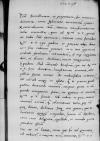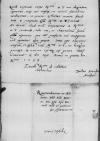Nolui commitere, quin ad Reverendissimam Dominationem Tuam, quantumvis rudes litteras exararem, maxime cum famulus Reverendissimae Dominationis Tuae (qui quidem in parentis aedes divertit) hinc reditum pararet, ne si tam opportunam scribendi facultatem intermitterem, id meae ingratitudini, ne dicam stultitiae, merito assignaretur. Equidem illud immortale beneficium, quo me Reverendissima Dominatio Tua hinc discedens locupletissime ornavit, alto pectore fixum manet. Ac mediusfidius interea, mihi nil est magis in optatis, quam ut possim qualiter qualem demerendi occasionem arripere, quam si aliquando consecutus fuero, me gratum et memorem, Reveredissima Dominatio Tua sentiet. Sed malim re ipsa meum istiusmodi animum quam calami stratis verbis, quae mihi quoque desunt, declarare. Itaque rem ipsam, quae voluntatem egregiam comprobet, summo cum desiderio, omni cum diligentia expectabo et iocunda promptitudine offeram.
Etsi me non lateat omnia quae hic vel geruntur, vel audiuntur, a maximis viris certissime Reverendissimae Dominationi Tuae
 BCz, 1597, p. 114
perscribi, nihilominus tamen et ego nonnula Reverendissimae Dominationi Tuae significare statui, ut aliquod tantummodo officii signum praeberem.
BCz, 1597, p. 114
perscribi, nihilominus tamen et ego nonnula Reverendissimae Dominationi Tuae significare statui, ut aliquod tantummodo officii signum praeberem.
Sigismund II Augustus Jagiellon (Zygmunt II August) (*1520 – †1572), 1529-1572 Grand Duke of Lithuania (ruled from 1544); 1530-1572 King of Poland (crowned vivente rege (ruled from 1548, after the death of his father); son of Sigismund I Jagiellon and Bona Sforza⌊Serenissimus rex noster iuniorSigismund II Augustus Jagiellon (Zygmunt II August) (*1520 – †1572), 1529-1572 Grand Duke of Lithuania (ruled from 1544); 1530-1572 King of Poland (crowned vivente rege (ruled from 1548, after the death of his father); son of Sigismund I Jagiellon and Bona Sforza⌋ nuper ab exercitu rediit, quem quidem admirabili cum animi dexteritate perlustrasse fertur. Rediit, inquam, cum splendidissima numerosissima et suspicienda panoplia. Ipsemet totus ac totus armorum insigni decore illustrabatur. Dicendo consequi non possum, quantus in spectando concursus et aplausus exstiterit afluentis populi.
Inter Petru IV Raresh (Petrylo) (*ca. 1487 – †1546), 1527-1538 and 1541-1546 Hospodar of Moldavia⌊ValachumPetru IV Raresh (Petrylo) (*ca. 1487 – †1546), 1527-1538 and 1541-1546 Hospodar of Moldavia⌋ et exercitum nostrum pax firma constituta est, iis conditionibus, ut nempe illa regio Pockuczie intercepta restituatur integra atque illata damna resarciantur, quae arbitrio serenissimorum regum, Ferdinand I of Habsburg (*1503 – †1564), from 1521 Archduke of Austria, from 1526 King of Bohemia and Hungary, Croatia and Slavonia as Ferdinand I, 1531-1558 King of the Romans, 1558-1564 Holy Roman Emperor; son of Philip I the Handsome and Joanna the Mad of Castile, a younger brother of Charles V of Habsburg⌊FerdinandiFerdinand I of Habsburg (*1503 – †1564), from 1521 Archduke of Austria, from 1526 King of Bohemia and Hungary, Croatia and Slavonia as Ferdinand I, 1531-1558 King of the Romans, 1558-1564 Holy Roman Emperor; son of Philip I the Handsome and Joanna the Mad of Castile, a younger brother of Charles V of Habsburg⌋ et John Zápolya (János Szapolyai) (*1487 – †1540), 1526-1540 King of Hungary; son of István Szapolyai and Jadwiga of Cieszyn in 1540 married Isabella, dauther of of King Sigismund Jagiellon of Poland. He fought against Ferdinand of Habsburg for the right to the title of King of Hungary⌊IoannisJohn Zápolya (János Szapolyai) (*1487 – †1540), 1526-1540 King of Hungary; son of István Szapolyai and Jadwiga of Cieszyn in 1540 married Isabella, dauther of of King Sigismund Jagiellon of Poland. He fought against Ferdinand of Habsburg for the right to the title of King of Hungary⌋ aestimari debent. Denique praestitum est iuramentum, nullam in posterum rebellionem adversus Poland (Kingdom of Poland, Polonia)⌊regnum PoloniaePoland (Kingdom of Poland, Polonia)⌋ motum iri.
Aiunt Suleiman the Magnificent (*1494 – †1566), 1520-1566 Sultan of the Ottoman Empire⌊Turcarum imperatoremSuleiman the Magnificent (*1494 – †1566), 1520-1566 Sultan of the Ottoman Empire⌋ populosissimis cum copiis ad Duchy of Moldavia (Valachia, Hospodarstwo Mołdawskie), country between the eastern Carpathians, the Dniester and the Danube delta, from 1456 a fiefdom of Turkey, where Polish and Turkish influences clashed in the 15th-16th centuries. The Latin name Valachia was widely used in Poland at the time to describe Moldavia, and not the Duchy of Wallachia, which was further south⌊MoldaviaeDuchy of Moldavia (Valachia, Hospodarstwo Mołdawskie), country between the eastern Carpathians, the Dniester and the Danube delta, from 1456 a fiefdom of Turkey, where Polish and Turkish influences clashed in the 15th-16th centuries. The Latin name Valachia was widely used in Poland at the time to describe Moldavia, and not the Duchy of Wallachia, which was further south⌋ fines venisse atque cogitare impressionem facere in Transylvania, region in the central part of Romania, bounded on the east and south by the Carpathian mountain range. Historical Transylvania extended in the west to the Apuseni Mountains⌊TransylvaniamTransylvania, region in the central part of Romania, bounded on the east and south by the Carpathian mountain range. Historical Transylvania extended in the west to the Apuseni Mountains⌋, ubi John Zápolya (János Szapolyai) (*1487 – †1540), 1526-1540 King of Hungary; son of István Szapolyai and Jadwiga of Cieszyn in 1540 married Isabella, dauther of of King Sigismund Jagiellon of Poland. He fought against Ferdinand of Habsburg for the right to the title of King of Hungary⌊rex IoannesJohn Zápolya (János Szapolyai) (*1487 – †1540), 1526-1540 King of Hungary; son of István Szapolyai and Jadwiga of Cieszyn in 1540 married Isabella, dauther of of King Sigismund Jagiellon of Poland. He fought against Ferdinand of Habsburg for the right to the title of King of Hungary⌋ validissimam militum manum collectam habet.
 BCz, 1597, p. 115
Decrevit The Ottoman Turks (Turcae) ⌊TurcarumThe Ottoman Turks (Turcae) ⌋ impetum fortiter excipere. Huic quoque Charles V of Habsburg (*1500 – †1558), ruler of the Burgundian territories (1506-1555), King of Spain as Charles I (1516-1556), King of Naples and Sicily, King of the Romans (1519-1530), Holy Roman Emperor of the German Nation (elected 1519, crowned 1530, abdicated 1556); son of Philip I the Handsome and Joanna the Mad of Castile⌊caesarCharles V of Habsburg (*1500 – †1558), ruler of the Burgundian territories (1506-1555), King of Spain as Charles I (1516-1556), King of Naples and Sicily, King of the Romans (1519-1530), Holy Roman Emperor of the German Nation (elected 1519, crowned 1530, abdicated 1556); son of Philip I the Handsome and Joanna the Mad of Castile⌋ et Ferdinand I of Habsburg (*1503 – †1564), from 1521 Archduke of Austria, from 1526 King of Bohemia and Hungary, Croatia and Slavonia as Ferdinand I, 1531-1558 King of the Romans, 1558-1564 Holy Roman Emperor; son of Philip I the Handsome and Joanna the Mad of Castile, a younger brother of Charles V of Habsburg⌊FerdinandusFerdinand I of Habsburg (*1503 – †1564), from 1521 Archduke of Austria, from 1526 King of Bohemia and Hungary, Croatia and Slavonia as Ferdinand I, 1531-1558 King of the Romans, 1558-1564 Holy Roman Emperor; son of Philip I the Handsome and Joanna the Mad of Castile, a younger brother of Charles V of Habsburg⌋ auxiliares copias miserunt, quibus dominus Hieronim Łaski (Jarosław Łaski, Hieronymus de Lasco) (*1496 – †1541), diplomat in the service of Sigismund I Jagiellon and John I Zápolya, representing them in diplomatic contacts with Ferdinand I of Habsburg and Sultan Suleiman I; 1520-1522 Crown Carver, 1522-1523 Voivode of Inowrocław, 1523-1541 Voivode of Sieradz, from 1528 Zupan of the Spiš district; from 1530 Voivode of Transylvania (PSB 18, p. 225-229)⌊LasckyHieronim Łaski (Jarosław Łaski, Hieronymus de Lasco) (*1496 – †1541), diplomat in the service of Sigismund I Jagiellon and John I Zápolya, representing them in diplomatic contacts with Ferdinand I of Habsburg and Sultan Suleiman I; 1520-1522 Crown Carver, 1522-1523 Voivode of Inowrocław, 1523-1541 Voivode of Sieradz, from 1528 Zupan of the Spiš district; from 1530 Voivode of Transylvania (PSB 18, p. 225-229)⌋ praeest. Faxit clementissimus Jesus of Nazareth (Jesus Christ), in Christianity the Messiah foretold in the Old Testament⌊ChristusJesus of Nazareth (Jesus Christ), in Christianity the Messiah foretold in the Old Testament⌋, ut tandem istius infestissimi tiranni intolerabilis potentia infringatur. Cuius rei nunc spes quam optima passim illucescit, dum universus fere Christianorum orbis incipit paratam concordiam longe lateque diffundere. Quod faustum felix et perpetuum sit.
BCz, 1597, p. 115
Decrevit The Ottoman Turks (Turcae) ⌊TurcarumThe Ottoman Turks (Turcae) ⌋ impetum fortiter excipere. Huic quoque Charles V of Habsburg (*1500 – †1558), ruler of the Burgundian territories (1506-1555), King of Spain as Charles I (1516-1556), King of Naples and Sicily, King of the Romans (1519-1530), Holy Roman Emperor of the German Nation (elected 1519, crowned 1530, abdicated 1556); son of Philip I the Handsome and Joanna the Mad of Castile⌊caesarCharles V of Habsburg (*1500 – †1558), ruler of the Burgundian territories (1506-1555), King of Spain as Charles I (1516-1556), King of Naples and Sicily, King of the Romans (1519-1530), Holy Roman Emperor of the German Nation (elected 1519, crowned 1530, abdicated 1556); son of Philip I the Handsome and Joanna the Mad of Castile⌋ et Ferdinand I of Habsburg (*1503 – †1564), from 1521 Archduke of Austria, from 1526 King of Bohemia and Hungary, Croatia and Slavonia as Ferdinand I, 1531-1558 King of the Romans, 1558-1564 Holy Roman Emperor; son of Philip I the Handsome and Joanna the Mad of Castile, a younger brother of Charles V of Habsburg⌊FerdinandusFerdinand I of Habsburg (*1503 – †1564), from 1521 Archduke of Austria, from 1526 King of Bohemia and Hungary, Croatia and Slavonia as Ferdinand I, 1531-1558 King of the Romans, 1558-1564 Holy Roman Emperor; son of Philip I the Handsome and Joanna the Mad of Castile, a younger brother of Charles V of Habsburg⌋ auxiliares copias miserunt, quibus dominus Hieronim Łaski (Jarosław Łaski, Hieronymus de Lasco) (*1496 – †1541), diplomat in the service of Sigismund I Jagiellon and John I Zápolya, representing them in diplomatic contacts with Ferdinand I of Habsburg and Sultan Suleiman I; 1520-1522 Crown Carver, 1522-1523 Voivode of Inowrocław, 1523-1541 Voivode of Sieradz, from 1528 Zupan of the Spiš district; from 1530 Voivode of Transylvania (PSB 18, p. 225-229)⌊LasckyHieronim Łaski (Jarosław Łaski, Hieronymus de Lasco) (*1496 – †1541), diplomat in the service of Sigismund I Jagiellon and John I Zápolya, representing them in diplomatic contacts with Ferdinand I of Habsburg and Sultan Suleiman I; 1520-1522 Crown Carver, 1522-1523 Voivode of Inowrocław, 1523-1541 Voivode of Sieradz, from 1528 Zupan of the Spiš district; from 1530 Voivode of Transylvania (PSB 18, p. 225-229)⌋ praeest. Faxit clementissimus Jesus of Nazareth (Jesus Christ), in Christianity the Messiah foretold in the Old Testament⌊ChristusJesus of Nazareth (Jesus Christ), in Christianity the Messiah foretold in the Old Testament⌋, ut tandem istius infestissimi tiranni intolerabilis potentia infringatur. Cuius rei nunc spes quam optima passim illucescit, dum universus fere Christianorum orbis incipit paratam concordiam longe lateque diffundere. Quod faustum felix et perpetuum sit.
De meo statu quaedam adscribere placuit. Cracow Town Council ⌊Senatus CracoviensisCracow Town Council ⌋ decrevit me suis actis et epistulis superiorem praeficere, idque me inscio nec tale quidquam ambiente. Ita mihi nudiustertius dominus pater retulit, qui id temporis magistri civium officio fungitur. Ego quid faciam? Non sane contemnam istiusmodi insperatam vocationem. Deinde vero parentis et amicorum consiliis acquiescam. Postremo patriae commodis studere cupio. Nec parum iuvabit studiorum meorum rationem iste domesticus usus forensis. Perspectis enim patriis ins<ti>tutis atque iudiciis in Italy (Italia)⌊ItaliamItaly (Italia)⌋ redire stat sententia. Quo tum cum fructu iuris studia repeterem, multorum in hac scientia doctissimorum virorum et vetera et nova exempla docent. Deus mea coepta feliciter promoveat.
Quod superest, enixe Reverendissimam Dominationem Tuam oro, dignetur ignoscere meae sat ineptae ac nimium familiari verbositati, in quam (illectus innata facilitate et perspecta gratia Reverendissimae Dominationis Tuae) incidi. Ac demum illud unum enixissime a Reverendissima Dominatione Tua contendo, velit me in clientulorum suorum album reponere, quo mihi profecto nil antiquius nil optatius esse potest. Deus Optimus alacrem amoenam et felicem vitam Reverendissimae Dominationi Tuae in longum proroget, ex animo etiam atque etiam precor.
 BCz, 1597, p. 114
perscribi, nihilominus tamen et ego nonnula Reverendissimae Dominationi Tuae significare statui, ut aliquod tantummodo officii signum praeberem.
BCz, 1597, p. 114
perscribi, nihilominus tamen et ego nonnula Reverendissimae Dominationi Tuae significare statui, ut aliquod tantummodo officii signum praeberem.
 BCz, 1597, p. 115
Decrevit
BCz, 1597, p. 115
Decrevit 


